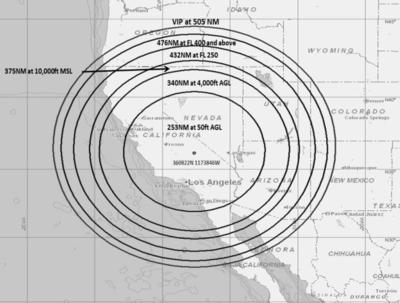Thu, Jun 09, 2016
Signals May Be Intermittently Unreliable Or Unavailable During The Month Of June
The FAA is conducting a series of GPS interference tests on the west coast of the U.S. during the month of June.

The testing began Tuesday centered at 360822N/1173846W or the BTY VOR 214 degree radial at 059 NM. The agency issued a NOTAM indicating that GPS signals may be unreliable or unavailable during the testing periods.
Additional tests are scheduled as follows:
- 9 JUN 16 1630Z – 2230Z
- 21 JUN 16 1630Z – 2230Z
- 23 JUN 16 1630Z – 2230Z
- 28 JUN 16 1630Z – 2230Z
- 30 JUN 16 1630Z – 2230Z
The altitude at which the reliability of GPS signals may be effected decreases depending on an aircraft's proximity to the testing site. According to the FAA, signals are affected as follows:
- 432NM RADIUS AT FL250
- 375NM RADIUS AT 10000FT
- 340NM RADIUS AT 4000FT AGL
- 253NM RADIUS AT 50FT AGL
The FAA singled out operators of Embraer Phenom 300 jets to pay particular attention to the NOTAM. According to the FAA, Embraer has recently received a report of GPS 1 and 2 simultaneous signal loss during fms navigation in cruise flight followed by a GPS HSI 1 and 2 failure indication, attitude and heading reference system (AHRS) 1 and 2 fault and, after a few minutes, a stall warning protection system (SWPS) fault, ventral rudder fail, yaw damper fail, auto pilot fail, and cas messages associated with unexpected rolling and yawing oscillations (dutch roll) at high airspeeds.
Further analysis revealed GPS constellation signal instability in the flight area leading to loss of both gps information data and causing the event described above. The AHRS continuously calculates and applies altitude and heading measurement updates to correct gyro-integrated altitude and heading during flight maneuvers and, in normal operation, the ahrs relies upon GPS, air data system and magnetic field measurements supplied by the magnetometer to maintain primary ahrs operation mode.
The dutch roll behavior may be expected for an airplane with no yaw damper and/or ventral rudder protection, especially on aircraft with swept wings. If this anomaly occurs controllers can expect the pilot may reduce speed below 240 kias and initiate an emergency descent.
All operational personnel must be briefed on this notice as soon as possible.
The FAA recommends that operators of Phenom jets avoid the test area during times that tests are being conducted.
(FAA image)
More News
He Attempted To Restart The Engine Three Times. On The Third Restart Attempt, He Noticed That Flames Were Coming Out From The Right Wing Near The Fuel Cap Analysis: The pilot repor>[...]
Make Sure You NEVER Miss A New Story From Aero-News Network Do you ever feel like you never see posts from a certain person or page on Facebook or Instagram? Here’s how you c>[...]
From 2009 (YouTube Edition): Leading Air Show Performers Give Their Best Advice for Newcomers On December 6th through December 9th, the Paris Las Vegas Hotel hosted over 1,500 air >[...]
Aero Linx: NASA ASRS ASRS captures confidential reports, analyzes the resulting aviation safety data, and disseminates vital information to the aviation community. The ASRS is an i>[...]
“For our inaugural Pylon Racing Seminar in Roswell, we were thrilled to certify 60 pilots across our six closed-course pylon race classes. Not only did this year’s PRS >[...]
 NTSB Final Report: Rutan Long-EZ
NTSB Final Report: Rutan Long-EZ ANN FAQ: Turn On Post Notifications
ANN FAQ: Turn On Post Notifications Classic Aero-TV: ICAS Perspectives - Advice for New Air Show Performers
Classic Aero-TV: ICAS Perspectives - Advice for New Air Show Performers ANN's Daily Aero-Linx (06.28.25)
ANN's Daily Aero-Linx (06.28.25) Aero-News: Quote of the Day (06.28.25)
Aero-News: Quote of the Day (06.28.25)



